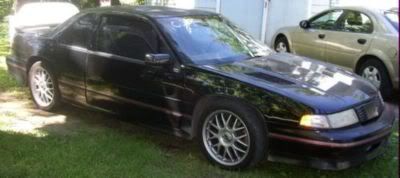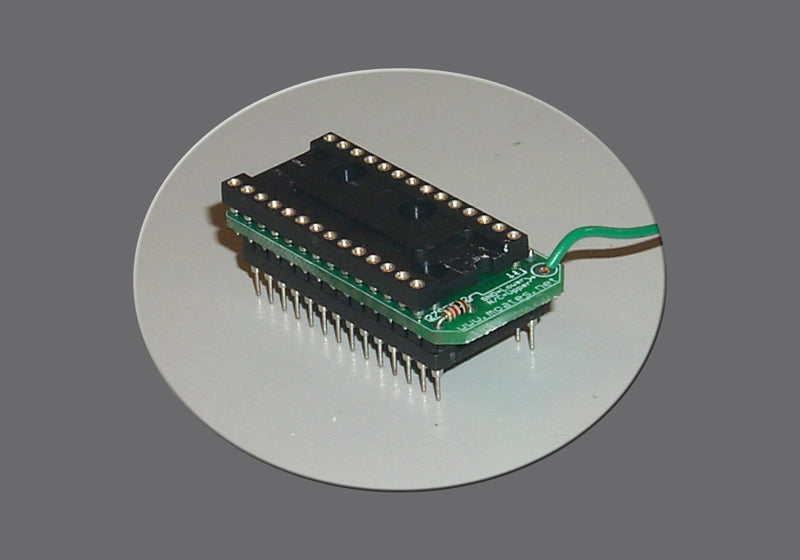fun little project for anyone proficient with a soldering iron....
i did some reading HERE
and understand binary MUCH better, but more importantly, i now understand how PROMs are read, and what the purpose is of the many addressing lines.
now, when it comes to PROMs of different capacities, but still using the same package and for the most part, the same pinouts(27C128,27C256,27C512 as used in GM P4 OBD1 ECM/PCMs), it becomes a game of very simple changes necessary to stick in a higher capacity PROM and be able to use all of the space it grants, rather than just the one "block" used to store 1 tune.
now, if we constantly apply 5 volts to a specific address pin, it will always be locked to a "1". now, if we use a 27SF512 for an example in a application that originally used a 27C256, all of the addressing lines will be used normally, except for the most-significant one (A15). now, normally, that pin is going to always be 0(no voltage at pin), so the ECM will use the information found in bytes 8000-FFFF. however, if we apply 5 volts to the pin, then it will use the information found in 0000-7FFF. are we starting to see how this could be useful?
now, since the pin will normally be 0 volts at all times in an application that originally used a 256(or even a 128 ), then all we would need is to have a way to connect and disconnect the 5Volt supply at one of the pins on the SF512. the diagram half-way down the page is a VERY good example of what to do. i've taken a look at the moates 2-timer and it looks like they use a 1K resistor, not the 4.7K shown in the diagram. regardless, they're cheap and common resistors.
conveniently, Vcc/Vdd and A15 are directly across from one another as you'll see in the diagram i have uploaded. since i don't like the idea of having stuff that is hard to interchange if/when stuff breaks, i have a couple of 28-pin DIP sockets on the way, which i will be soldering the resistor to so in case the SF512 dies on me, i can pry it out of the DIP socket and replace it in seconds, rather than desoldering the damn thing.
now, according to the diagram, the switch is between the resistor and A15 pin(it says A14, but that's because they are referencing a 27C128 application, not a 27C256). and the other terminal of the switch goes to ground, and then allows for pin A15 to be switched between 5V and 0V, allowing for 8000-FFFF and 0000-7FFF respectively.
now another little trick
if you look at the SF512 diagram a little closer and know some electrical stuff, you'll notice that pin 14 (Vss) is a ground, which is at the bottom of the row that the A15 pin is in. now that can make your job even simpler, since you won't have to try and find/make a ground somewhere in car, assuming you don't want the switch somewhere outside of the ECM. if you want the switch mounted on the dash, for example, you should ground elsewhere, since making a ground cable go all the way back to the ECM is likely longer than it would need to be.
so, for all the other DIY OBD1 tuners out there, go nuts, since all of this can be implimented for less than $5 and a couple of minutes of time. larger capacity chips can also be used, but are a bit more complex.
i did some reading HERE
and understand binary MUCH better, but more importantly, i now understand how PROMs are read, and what the purpose is of the many addressing lines.
now, when it comes to PROMs of different capacities, but still using the same package and for the most part, the same pinouts(27C128,27C256,27C512 as used in GM P4 OBD1 ECM/PCMs), it becomes a game of very simple changes necessary to stick in a higher capacity PROM and be able to use all of the space it grants, rather than just the one "block" used to store 1 tune.
now, if we constantly apply 5 volts to a specific address pin, it will always be locked to a "1". now, if we use a 27SF512 for an example in a application that originally used a 27C256, all of the addressing lines will be used normally, except for the most-significant one (A15). now, normally, that pin is going to always be 0(no voltage at pin), so the ECM will use the information found in bytes 8000-FFFF. however, if we apply 5 volts to the pin, then it will use the information found in 0000-7FFF. are we starting to see how this could be useful?
now, since the pin will normally be 0 volts at all times in an application that originally used a 256(or even a 128 ), then all we would need is to have a way to connect and disconnect the 5Volt supply at one of the pins on the SF512. the diagram half-way down the page is a VERY good example of what to do. i've taken a look at the moates 2-timer and it looks like they use a 1K resistor, not the 4.7K shown in the diagram. regardless, they're cheap and common resistors.
conveniently, Vcc/Vdd and A15 are directly across from one another as you'll see in the diagram i have uploaded. since i don't like the idea of having stuff that is hard to interchange if/when stuff breaks, i have a couple of 28-pin DIP sockets on the way, which i will be soldering the resistor to so in case the SF512 dies on me, i can pry it out of the DIP socket and replace it in seconds, rather than desoldering the damn thing.
now, according to the diagram, the switch is between the resistor and A15 pin(it says A14, but that's because they are referencing a 27C128 application, not a 27C256). and the other terminal of the switch goes to ground, and then allows for pin A15 to be switched between 5V and 0V, allowing for 8000-FFFF and 0000-7FFF respectively.
now another little trick
if you look at the SF512 diagram a little closer and know some electrical stuff, you'll notice that pin 14 (Vss) is a ground, which is at the bottom of the row that the A15 pin is in. now that can make your job even simpler, since you won't have to try and find/make a ground somewhere in car, assuming you don't want the switch somewhere outside of the ECM. if you want the switch mounted on the dash, for example, you should ground elsewhere, since making a ground cable go all the way back to the ECM is likely longer than it would need to be.
so, for all the other DIY OBD1 tuners out there, go nuts, since all of this can be implimented for less than $5 and a couple of minutes of time. larger capacity chips can also be used, but are a bit more complex.










Comment